The accession of the Serbian monarch was legitimised by a coronation ceremony, which was carried out by church officials.
The accession of the Serbian monarch was legitimised by a coronation ceremony, which was carried out by church officials.
The ritual of crowning a new ruler (royal enthronement) is attested in the 12th century. [1] The coronation of Serbian monarchs took place in the most prominent of churches in the country. [2] The coronation of the Grand Princes of Serbia was likely held at the church in Ras. [1] The successors of Stefan Nemanja adopted Byzantine ideas on self-rule and acts on the ruler's anointment and coronation. [3] The church official (archbishop, patriarch) anointed and crowned the ruler in the same ceremony. [3] Through the archiereus, with the act of crowning, God's grace transits to the ruler. [2]
The ritual of crowning a new ruler is attested in the 12th century. [1] The coronation of Serbian monarchs took place in the most prominent of churches in the country. [2] Stefan (r. 1196–1228), the son of Grand Prince Stefan Nemanja, was crowned with a crown sent by Pope Honorius III in 1217. [2] [4] According to Fine Jr., he was crowned by a papal legate. [5] It is unknown where the coronation took place. [6] J. Kalić believes that it was Peter's Church, Ras. [7] It has been assumed that Stefan was crowned a second time by Archbishop Sava, his brother. [8] In the second charter to the Žiča monastery dated to ca. 1224, King Stefan ordered for all future kings to be crowned at that monastery. [6] His contemporaries and successors called him "the First-Crowned King". [9]

Serbia's last and only modern coronation was in 1904, when King Peter I was crowned in an Eastern Orthodox Christian ceremony at the Cathedral of the Host of Holy Archangels in Belgrade. [10] [11] Serbia became a part of the state of Yugoslavia after World War I, but Peter did not hold a second coronation and neither of his two successors, the Yugoslav monarchs Alexander and Peter II, were crowned. This was due to the religious diversity of the new state.
Stefan's crown was called "the holy wreath" (sveti venac) by Domentijan. [4] Later, it was called "the god-gifted wreath of the Serbian kingdom" (bogodarovani venac kraljevstva srpskog). [4]
Modern Serbian regalia were created in Paris by the famous Falise brothers jewellers in 1904 for coronation of king Peter I Karađorđević, and consisted of a royal crown, orb, sceptre, mantle, and mantle buckle. The crown, known as the "Karađorđević Crown", was partially made out of a cannon that Karađorđe had used during the First Serbian Uprising, and was adorned with details such as the Serbian eagle and Serbian cross. The crown, scepter, and orb were decorated with gemstones extracted in Serbia and enameled in the Serbian national colours (red, blue, and white). The mantle was made out of purple velvet, embroidered with gold and lined with ermine fur.
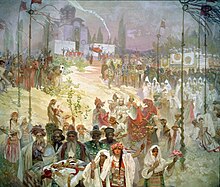
The sacredness of the Serbian throne is frequently stressed in medieval sources. [12] Apart from the throne, the crown was one of the most important royal insignia in the Middle Ages. [1]

Stefan Radoslav, also known as Stephanos Doukas, was the King of Serbia, from 1228 to 1233.
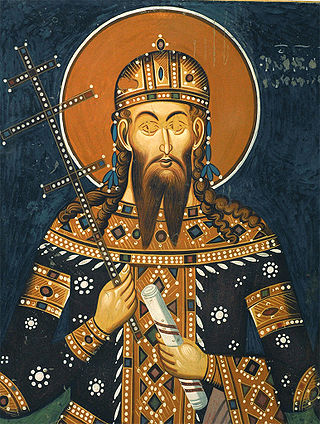
Saint Stefan Uroš V, known in historiography and folk tradition as Uroš the Weak, was the second Emperor (Tsar) of the Serbian Empire (1355–1371), and before that he was Serbian King and co-ruler with his father, Emperor Stefan Dušan.

Stefan Vladislav was the King of Serbia from 1234 to 1243. He was the middle son of Stefan the First-Crowned of the Nemanjić dynasty, who ruled Serbia from 1196 to 1228. Radoslav, the eldest son of Stefan the First-Crowned, was ousted by the Serbian nobility due to increasing Epirote influence through his marriage alliance to Theodore Komnenos Doukas; thus Vladislav became his successor. He is celebrated as Saint Vladislav by the Serbian Orthodox Church.
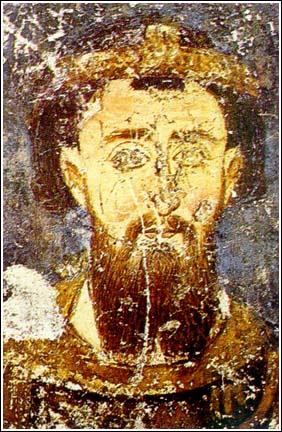
Stefan Nemanjić, known as Stefan the First-Crowned, was the Grand Prince of Serbia from 1196 and the King of Serbia from 1217 until his death in 1228. He was the first Rascian king; due to his transformation of the Serbian Grand Principality into the Kingdom of Serbia and the assistance he provided his brother Saint Sava in establishing the Serbian Orthodox Church, he is regarded one of the most important members of the Nemanjić dynasty.
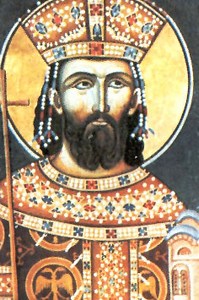
Lazar Hrebeljanović was a medieval Serbian ruler who created the largest and most powerful state on the territory of the disintegrated Serbian Empire. Lazar's state, referred to by historians as Moravian Serbia, comprised the basins of the Great Morava, West Morava, and South Morava rivers. Lazar ruled Moravian Serbia from 1373 until his death in 1389. He sought to resurrect the Serbian Empire and place himself at its helm, claiming to be the direct successor of the Nemanjić dynasty, which went extinct in 1371 after ruling over Serbia for two centuries. Lazar's programme had the full support of the Serbian Orthodox Church, but the Serbian nobility did not recognize him as their supreme ruler. He is often referred to as Tsar Lazar Hrebeljanović ; however, he only held the title of prince.

Stefan Uroš I, known as Uroš the Great was the King of Serbia from 1243 to 1276, succeeding his brother Stefan Vladislav. He was one of the most important rulers in Serbian history. During his reign the foundations were laid for the expansion of the Serbian medieval state, which would become an empire in the middle of the 14th century.

The Serbian Orthodox Church is one of the autocephalous Eastern Orthodox Christian churches.

The House of Nemanjić was the most prominent dynasty of Serbia in the Middle Ages. This princely, royal and imperial house produced twelve Serbian monarchs, who ruled between 1166 and 1371.

The Žiča Monastery is an early 13th-century Serbian Orthodox monastery near Kraljevo, Serbia. The monastery, together with the Church of the Holy Dormition, was built by the first King of Serbia, Stefan the First-Crowned and the first Head of the Serbian Church, Saint Sava.

The House of Lazarević was a Serbian medieval royal family, which ruled Moravian Serbia and the Serbian Despotate.

The name Stephen, long popular among South Slavic monarchs, was used as an honorific or as a royal title by various rulers of Serbia and claimants to the Serbian throne, most notably the Nemanjić kings of Serbia and the Kotromanić kings of Bosnia.

Pomorje, also known as the Lands of Pomorje, is a medieval term, used in Byzantine title, and at end of the 12th century, during the reign of Stefan Nemanja (1166–1196), inherited by Serbian monarchs, thus becoming part of the Serbian title, whose rulers were styled with the title: "crowned king and autocrat of all Serbian and coastal lands".
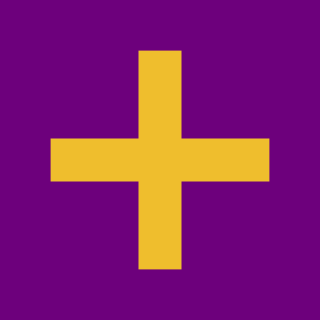
Between 1345 and 1371, the Serbian monarch was self-titled emperor (tsar). The full title was initially Emperor of the Serbs and Greeks, later Emperor of the Serbs, Greeks and Bulgarians in Serbian and basileus and autokrator of Serbia and Romania ["the land of the Romans"] in Greek. This title was soon enlarged into "Emperor and Autocrat of the Serbs and Greeks, the Bulgarians and Albanians". The Serbian Empire was ruled by only two monarchs; Stefan Dušan and Stefan Uroš V. Two other claimants of the title ruled in Thessaly, Central Greece.

The Kingdom of Serbia, or the Serbian Kingdom, was a medieval Serbian state that existed from 1217 to 1346 and was ruled by the Nemanjić dynasty. The Grand Principality of Serbia was elevated with the regal coronation of Stefan Nemanjić as king, after the reunification of Serbian lands. In 1219, Serbian Orthodox Church was reorganized as an autocephalous archbishopric, headed by Saint Sava. The kingdom was proclaimed an empire in 1346, but kingship was not abolished as an institution, since the title of a king was used as an official designation for a co-ruler of the emperor.
The Serbian monarchs and royalty have assumed several regnal titles and styles throughout history.

Stefan Konstantin was the King of Serbia from 29 October 1321 to the spring of 1322. The younger son of King Stefan Milutin (1282–1321), he initially held the appanage of Zeta, and was the heir to the Serbian throne after his father had exiled his elder brother Stefan. After his father's death, a throne struggle broke out between Konstantin, Stefan and their cousin Vladislav II, evolving into the two years long civil war. He was killed in the battle fighting his brother, who went on to defeat Vladislav, too, and gained the Serbian throne as Stefan Uroš III, better known as Stefan Dečanski.

Đuraš Ilijić was a Serbian commander and nobleman who served the Serbian monarchs Stefan Dečanski, Stefan Dušan and Uroš V, from 1326 until his death in 1362. He had the title of čelnik ("head"), and governed Upper Zeta. He is an ancestor of the Crnojević noble family.
Stavilac was a court title in Medieval Bosnia and Medieval Serbia in the Middle Ages. It was similar to the Byzantine court offices of domestikos and cup-bearer. It had a role in the ceremony at the royal table, though the holder could be entrusted with jobs that had nothing to do with court ritual. According to studies of Rade Mihaljčić, the holder was in charge of acquiring, preparing and serving food at the royal table. It was a confidant duty, given to the highest and most notable nobility, in which the ruler relied on in all occasions.
In the Medieval Serbian state, a range of court and honorific titles were used.
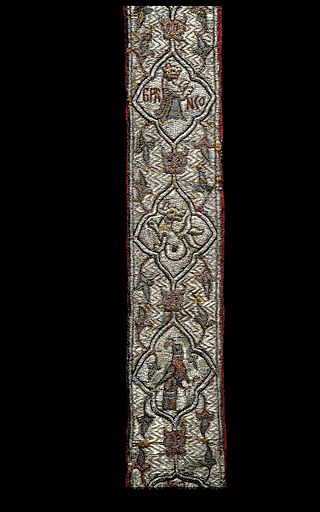
Branko was a Serbian magnate who served to king and emperor Stefan Dušan, and emperor Stefan Uroš V, with the titles of sluga and later sevastokrator. A member of an old and respectable family, possibly descending from the Serbian dynasty itself, Branko began his royal service in the nearest circle of the ruler. After the elevation of the Serbian state to the Empire (1346), Branko received the second-highest court title, sevastokrator, usually given to relatives. He governed the Ohrid region. Branko had three sons and a daughter, of whom Vuk Branković would become an important person in the period of the Fall of the Serbian Empire.